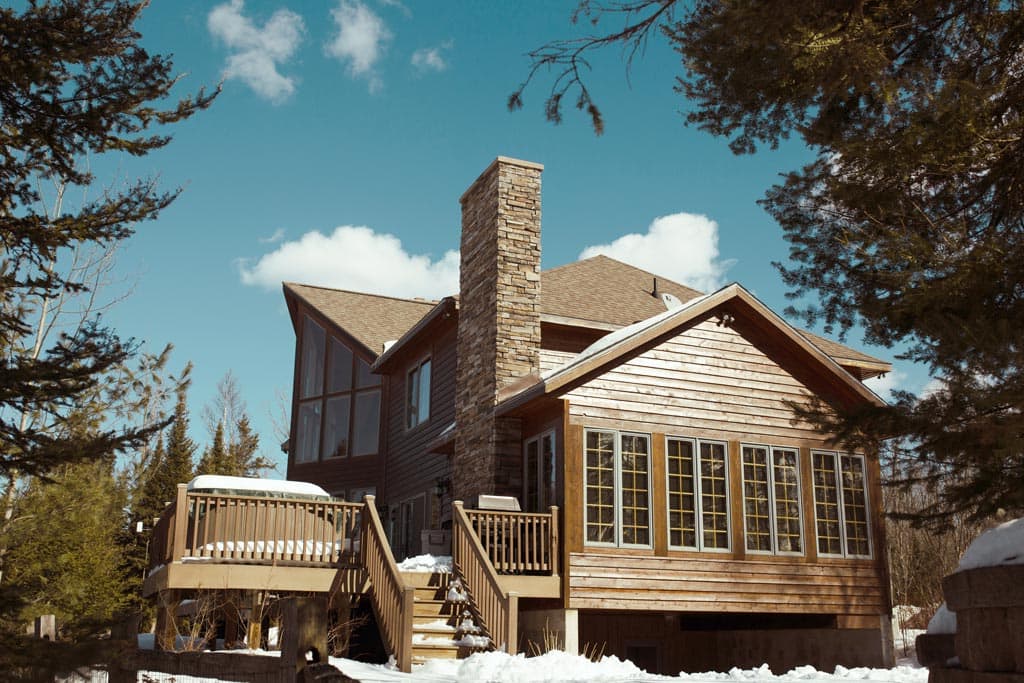
Fireplaces are designed to produce heat and help warm your home. So how can they also represent a nuisance to your heating bill? Your chimney is a vital component of the fireplace.
When it's in full operation it can help the fireplace serve its primary purpose and heat your home. However, when there are flaws in the structure it can actually add to your heating bill.
In this article, we will help you discover how you can use your chimney to work for you, and not against you.
Benefits & Disadvantages of Fireplaces
You could dedicate an entire article to the pros and cons of a fireplace. The bottom line is that its impossible to replicate the feeling and coziness of a natural wood stove or furnace. Even gas fireplaces can create some of that same comfort.
However, fireplaces are also detrimental when they're not in full working order. The chimney is the only way for intense heat and harmful gases to escape up and out of your home. When the chimney is flawed, it can pose serious health risks as well as fire danger.
When winter arrives, you don’t want to get stuck with a flawed chimney because it may make the fireplace inoperable until the repairs are made - sometimes not until the next spring or summer.
Homeowners are quick to blame drafty windows and doors for energy loss, which is understandable, yet also fail to correctly assess the proficiency of their chimney.
If you have a fireplace that you use often, it's mandatory to get it inspected and cleaned at least once a year. Failure to do so may not only violate building codes, but also pose a serious risk to you and your family. Additionally, inspecting your chimney for damage and repairs can help reduce energy costs.
Here are the primary culprits of what makes a fireplace chimney ADD to your heating costs, not reduce them:
Cracks in the Chimney
The chimney is not capable of doing its job without the correct flue. The flue functions as a pipe, duct, or opening in a chimney that conveys an exhaust system for harmful gases. It basically pulls dangerous gases from going into the exterior of your home and out the top of the chimney.

However, when the chimney is cracked, the flue is not going to function properly. The flue lining is the usual culprit. Modern chimneys need a liner to protect from fire hazards as well as prevent carbon monoxide exposure into the home.
Liners are constructed either with clay tiles, cast-to-place concrete, or types of metal like stainless steel and aluminum. Regardless of the type of chimney liner, they all have lifespans. Once the liner begins to crack, it no longer serves its purpose. The expanding of the flue lining can result in vertical cracks which provide an escape for heat into the home as well as lethal carbon monoxide.
Are your energy costs going up? In addition to checking for drafts in windows and doors you should also get the chimney liner inspected. It may be time for a complete replacement.
Dampness in the Flue
If you didn’t already notice, the flue in a chimney is pretty sensitive. When it gets damp it does not work efficiently. The humidity combines with sulfates which accumulate and, over time, produce acids which destroy mortar joints and brickwork inside the fireplace.
The problem with dampness from the flue is that it's rarely visible. Only a trained eye from a chimney professional will be able to diagnose the issue. The cracks are often minuscule yet contribute to energy loss.
Damaged Damper on Top of Chimney
The damper is basically a trap door at the top or bottom of the chimney. The damper is usually built with a metal or cast-iron. Dampers are produced in different styles yet serve the same function.
You can open or shut the trap door when not in use to help control heating costs (see more information, below). When doing so you should also check to inspect if the damper is damaged.
According to one study, a damaged damper can raise overall energy consumption by 30 percent. In other words, that is approximately $200 more spent each year on heating costs. Can you afford that increase on your energy bill?
Dampers sit directly above intense heat so it's not extremely unusual for them to crack or warp over time. When the damper is disfigured, it’s not going to fit snugly over your chimney and thus will release heat. So consider replacing the damper if your heating costs have been rising as of late.
Open Damper Leads to Higher Energy Costs
You can close the damper when the fireplace is not in use. It is a good idea if you rarely use the fireplace, even in the winter, or may be going on vacation and want to trap some heat while you are away.
Some dampers can close halfway to still provide ventilation while also reducing the chance of controlled heat to escape through the top. It depends on personal preference, just make sure you have the damper at least partially opened when you go to light the fireplace or you’re living space will immediately get filled with a cloud of smoke!
Hire Chimney Inspectors
It is sometimes small things, yet a flawed chimney does result in heat loss. So if you have noticed a recent spike in heating bills that seems a little unusual, while you also do home inspections in the windows and doors make sure you don’t forget the chimney.

It is sometimes an easy fix, sometimes a more expensive one - yet making sure your chimney is working correctly can not only lower energy costs, but also keep your family safe from potential health hazards and fire dangers.
Chicago land homeowners look to one name when they need their chimney inspected and repaired - Vertical Chimney Care. Contact us for any of your chimney service needs.
